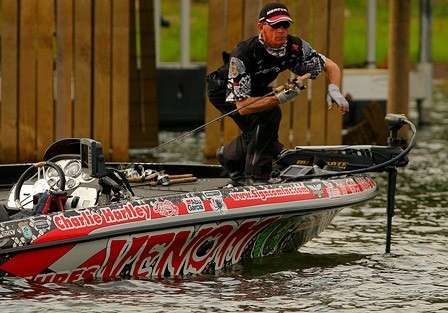
Do you remember those hot summer days as a child when you would open your tacklebox only to discover that your prized plastic worms had melted into one giant discolored glob? Charlie Hartley, Elite Series pro and fastidious organizer, has experienced that scenario all too often. He has developed a strategy to keep his plastics in top form throughout the year.
Competing at the highest levels of the sport, Hartley explains that soft plastics storage and organization is a critical process that can't be overlooked. "I'd hate to weigh the amount of soft plastics I carry while I'm on the road fishing the Elite Series," he says. "I would guess that at any given time I've got around 300 pounds of soft plastics in my truck and my boat."
With that much inventory, most of which is in bulk quantity, Hartley explains that storing the baits by color and type for quick access is the first step. Keeping the baits straight in storage is another. "I store all my bulk plastics in the truck and will put what I'm going to use daily in individual Ziploc® bags so that the colors don't bleed together," he says.
"When you do that, it's critical that all your baits stay straight. If they're folded or bent when they're stored, they'll retain that shape when you take them out of the bag."
So what happens if one or two of the baits is bent while storing? Hartley explains that he's heard of remedies, but due to his diligence hasn't had to try one yet. "I've heard of microwaving plastics to get them straightened back out but I've never done it," he says. "I just try to go out of my way to make sure that that never happens.
"To be honest with you, straightening soft plastic baits is just something I don't have the time to bother with, so I go to great lengths to make sure it doesn't happen in the first place."
Hartley houses the Ziploc® bags (arranged so they're straight) in clear plastic tackleboxes in his boat. The bigger quantities are stored in his truck in Rubbermaid totes. "I've always joked that I should be sponsored by Ziploc® because of the number of bags I go through," he says.
"It's quite a process to rotate the baits out of the truck and into the bags, but it's a really important part of my tackle preparation."
As Hartley moves baits from his truck to the storage bags, he gives each a quick spray of scent before sealing. "It not only helps align them as they go into the storage bags but it also keeps them all slimy and smelling good," he points out. "You're kind of killing two birds with one stone when you do that."
With today's improved plastics, Harley explains that storing them in consistent temperatures isn't as important as it once was. "Obviously, I carry a lot of my plastics in the truck where there are extreme temperatures," he says. "I've never really had a problem with temperature. The new plastics are just a lot more durable and less prone to temperature fluctuations."
Harley points out that while the typical angler isn't likely to carry 300 pounds of soft plastics, proper storage and organization are still critical. "You don't have to have a fanatical organizational system to keep everything straight, just something simple that keeps everything in its place," he says.
"The only thing that's worse than not having something is having it and not being able to find it."
Originally published May 2008




